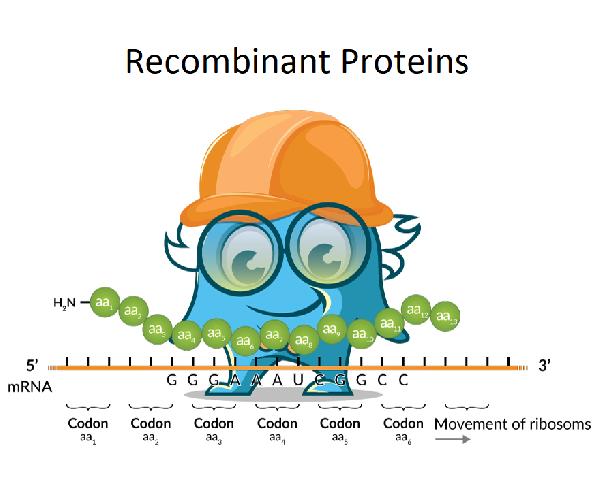Product Info Summary
| SKU: | PROTP18428 |
|---|---|
| Size: | 2ug, 5ug, 10ug |
| Origin Species: | Human |
| Source: | CHO cells |
Customers Who Bought This Also Bought
Product info
Product Name
LBP Lipopolysaccaride Human Recombinant Protein
View all LBP recombinant proteins
SKU/Catalog Number
PROTP18428
Size
2ug, 5ug, 10ug
Description
The Lipopolysaccharide Binding Protein is produced from human LBP transfected CHO-cells in serum free medium. Before transfection the complete human LBP-cDNA was amplified by PCR and cloned into expression vector p-POL-DHFR. The recombinant Human LBP was purified by his-tag with metal affinity purification with Talon and controlled by SDS page. Showing a 58kDa band on SDS-PAGE. Attention: His-tag has no protease site and can not be split off.
Storage & Handling
Lyophilized LBP Human Recombinant although stable at room temperature for 3 weeks, should be stored desiccated below -18°C. Upon reconstitution LBP should be stored at 4°C between 2-7 days and for future use below -18°C.Please prevent freeze-thaw cycles.
Cite This Product
LBP Lipopolysaccaride Human Recombinant Protein (Boster Biological Technology, Pleasanton CA, USA, Catalog # PROTP18428)
Form
Sterile Filtered White lyophilized (freeze-dried) powder.
Formulation
Recombinant Human LBP was lyophilized from a protein solution (0.3mg/ml) containing phosphate-buffered saline, pH 7.2.
Predicted MW
53.384kDa
Reconstitution
Every 10µg of recombinant human LBP should be reconstituted using 33µl of sterile H2O. The solution can be than diluted with phosphate-buffered saline or other buffers.
Biological Activity
Up to 0.2 µg/ ml LBP mediates binding of FITC-LPS (0.5µg/ml) to CD14+CHO transfectants (FACS).
Assay dilution & Images
Reconstitution
Every 10µg of recombinant human LBP should be reconstituted using 33µl of sterile H2O. The solution can be than diluted with phosphate-buffered saline or other buffers.
Validation Images & Assay Conditions

Click image to see more details
Recombinant protein fun image
Protein Target Info & Infographic
Gene/Protein Information For LBP (Source: Uniprot.org, NCBI)
Gene Name
LBP
Full Name
Lipopolysaccharide-binding protein
Weight
53.384kDa
Superfamily
BPI/LBP/Plunc superfamily
Alternative Names
Lipopolysaccharide-binding protein; LBP; MGC22233 LBP BPIFD2 lipopolysaccharide binding protein lipopolysaccharide-binding protein|BPI fold containing family D, member 2|LPS-binding protein
*If product is indicated to react with multiple species, protein information is based on the gene entry specified above in "Species".For more info on LBP, check out the LBP Infographic

We have 30,000+ of these available, one for each gene! Check them out.
In this infographic, you will see the following information for LBP: database IDs, superfamily, protein function, synonyms, molecular weight, chromosomal locations, tissues of expression, subcellular locations, post-translational modifications, and related diseases, research areas & pathways. If you want to see more information included, or would like to contribute to it and be acknowledged, please contact us at [email protected].
Specific Publications For LBP Lipopolysaccaride Human Recombinant Protein (PROTP18428)
Hello CJ!
No publications found for PROTP18428
*Do you have publications using this product? Share with us and receive a reward. Ask us for more details.
Recommended Resources
Here are featured tools and databases that you might find useful.
- Boster's Pathways Library
- Protein Databases
- Bioscience Research Protocol Resources
- Data Processing & Analysis Software
- Photo Editing Software
- Scientific Literature Resources
- Research Paper Management Tools
- Molecular Biology Software
- Primer Design Tools
- Bioinformatics Tools
- Phylogenetic Tree Analysis
Customer Reviews
Have you used LBP Lipopolysaccaride Human Recombinant Protein?
Submit a review and receive an Amazon gift card.
- $30 for a review with an image
0 Reviews For LBP Lipopolysaccaride Human Recombinant Protein
Customer Q&As
Have a question?
Find answers in Q&As, reviews.
Can't find your answer?
Submit your question





